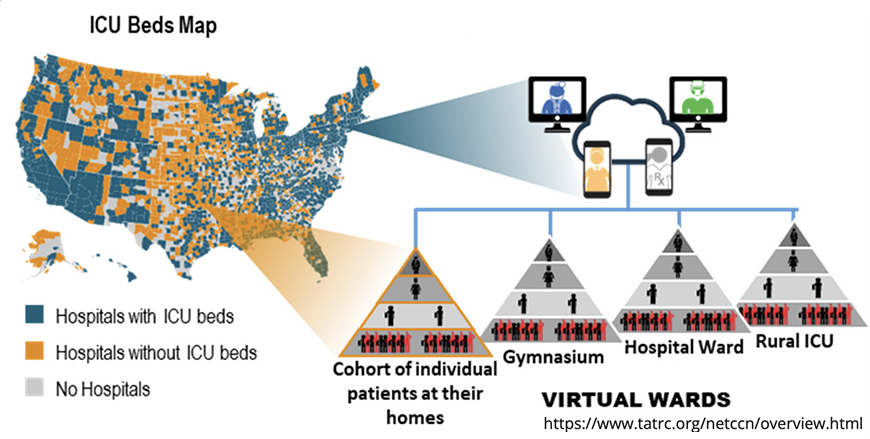Telemedicine Command and Control - Case Study
DocBox and Smilefish partner to provide an interoperable telemedicine data solution for NETCCN

Executive Summary
The Research and Development to create the National Emergency Tele-Critical Care Network (NETCCN) is a response to the critical shortage of critical-care trained clinicians during the COVID healthcare crisis. It is a growing network of clinical care teams that use network-enabled mobile devices such as cell phones, tablets, and computers to provide expert medical advice to patients in need, regardless of location. DocBox, with the help of Smilefish, collaborated with the rest of the NETCCN teams to create the proof of concept of a cross-platform application module solution that enables multiple telemedicine solutions to send data in an interoperable way to real-time situational awareness of the NETCCN ecosystem, removing the need for manual daily reporting for national care metrics.
Problem Statement:
In a previous project phase, DocBox and Smilefish presented remote patient monitoring and telemedicine integration capabilities. The next project phase focused on developing a reporting solution with HL7/FHIR standard-based APIs. The solution needed to allow telemedicine providers to submit patient encounters directly from their systems as they occurred. The reporting system was required to provide consistent data aggregation across all telemedicine providers to rapidly deliver command and control analytics. The team chose an HL7/FHIR-based API for the telemedicine providers to send us data and created an analytical API for the NETCCN Central Command and Control Application to deliver Analytics and Visualization.
Vendor Selection:
The Smilefish Data Fabric, based on open-source, was an ideal foundation to implement the project requirements. It provided user management, governance, and reporting functionalities ready for customization. Integrating an open-source FHIR data model and REST services became a standard configuration task. The Data Fabric's universal connector layer provided customizable data APIs for telemedicine partners to submit their daily data. The ETL and data science layers were extensible to meet custom data aggregation requirements. Finally, the application layer provided customizable APIs to Expression Networks to retrieve the reporting information for upward reporting.
Implementation in the AWS Cloud:
Smilefish offers a pre-configured Data Fabric solution on the AWS cloud, built following the AWS well-architected framework to ensure operational excellence, security, performance, and durability. The decision to use AWS for the POC and MVP phases was an obvious choice that helped expedite development. However, the need for a cloud-agnostic implementation had an impact on the technology choices:
- HL7/FHIR data, user management, and configuration data are stored in a high-performance AWS RDS Postgres database, which meets compatibility requirements with the existing DocBox infrastructure and can be ported easily to on-premises Postgres or other cloud environments.
- The data services are deployed on AWS EC2 to achieve maximum compatibility with local deployment. Migration to serverless AWS Lambda can further enhance scalability and minimize maintenance.
- The AWS Simple Notification Service (SNS) is integrated in the web services.
- The native analytics dashboards are supported by Smilefish Data Fabric APIs and deployed via AWS S3 and AWS CloudFront. The dashboards utilize AWS RDS data queries embedded in APIs that also support self-service analytics (i.e., Tableau or Looker)
- AWS CloudWatch monitors the system's health and notifies admin users via AWS SNS should manual interference be needed.
Relying entirely on open-source technology allowed Smilefish and DocBox to migrate the solution to the Google Cloud Platform (GCP) for production without encountering any blocking issues. This approach highlights the flexibility and solution compatibility with different cloud platforms, enabling a smooth transition to the desired production environment.
Outcome:
Choosing the Smilefish Data Fabric was an excellent foundation for implementing the FHIR-based reporting solution for NETCCN. The POC required minimal customization and development effort, allowing NETCCN partners to rely on stable APIs while integrating with their systems. The Data Fabric's customizable dashboard application was a bonus, providing monitoring capabilities during the QA and integration cycles for all parties involved.
Updates:
This project was named as one of the 2023 Disruptive Technology Award winners for Administration for Strategic Preparedness and Response within Health and Human Services. (2023 Disruptive Technology Award)

